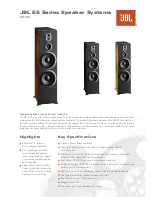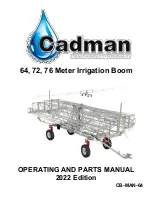
control, which introduces an inverted voltage to both filters to control their distance from the center Cutoff
(e.g. a positive voltage input to the Bandwidth CV jack will simultaneously increase the cutoff frequency of
the Low Pass Filter section and decrease the cutoff frequency of the High Pass Filter section in equal
amounts).
This filter takes the concept further, however! In traditional filtering, summing a phase-inverted Band Pass
signal with the filter input creates a Notch filter, and the concept works well with this filter’s Variable
Bandwidth output. In this case, the inverted input is summed with the regular Variable Bandwidth A output
and then the mix is inverted again; this nominally produces a Notch or Band Reject output which is in
phase with the input but a phase-canceled version of VBW A. As such, with the Variable Bandpass Filter
fully “open” (Cutoff Frequency knob in center, Bandpass knob fully clockwise), the Notch output will be
almost entirely silent due to full phase cancellation of the input signal.
We also added a transistor-based switching circuit through which the Variable Bandwidth A signal is
routed, which creates the Variable Bandwidth B output. This simple circuit is lovely for creating electric
guitar or bowed cello sounds, or can approximate the sound of Pulse-Width Modulation in some
configurations. This functionality was inspired by the lovely aggressive sounds of the bottom section of
the Serge Wave Multipliers module, though the circuit itself is entirely different.
3. Summary of Functions
Cutoff Frequency:
Sets the central frequency of the filter relative to the cutoffs of each filter section.
Bandwidth:
Manual control of the Bandwidth of Variable Bandwidth A and B where CW = greater
bandwidth up to approx. 8 octaves at Maximum setting.
Resonance:
Controls the Resonance/Q setting of both filters simultaneously.
Freq CV:
Input for Cutoff Frequency CV. The adjacent knob is an attenuverter capable of providing up to
+/-1x gain, the output of which is then added to the Cutoff Frequency knob setting.
Res CV:
Input for Resonance CV. The adjacent knob is an attenuverter capable of providing up to +/-1x
gain, the output of which is then added to the Resonance knob setting.
BW CV:
Input for Bandwidth CV. The adjacent knob is an attenuverter capable of providing up to +/-1x
gain, the output of which is then added to the Bandwidth knob setting.
1V/Oct
↑
:
Un-attenuated CV input which (only) controls the cutoff of the High Pass filter section.
1V/Oct
↓
: Un-attenuated CV input which (only) controls the cutoff of the Low Pass filter section.
A-Audio In-B:
Unity Gain audio inputs. These two inputs are summed before passing to the input of the
first filter stage.
HP Out:
12dB/Oct High Pass Filter output. The cutoff of this output is controlled by the master Cutoff
Frequency, Bandwidth, and 1V/Oct ↑ controls.
BP Out A:
Output of the first Band Pass Filter. The central frequency of this filter output is the same as
HP Out and Bandwidth can not be varied.
BP Out B:
Output of the second Band Pass Filter. The central frequency of this filter output is the same
as the Low Pass Filter which forms the final stage of the Variable Bandwidth A output, and can be
controlled directly via the 1V/Oct ↓ control input.
Notch Out:
Output of the Notch Pass Filter, produced by summing the Variable Bandwidth A output with
the inverted Audio input post-Mixer section. This output will cancel the phase of frequencies within the
bandwidth of the Variable Bandwidth A output effectively with Resonance turned fully CCW, while
boosting those frequencies more and more as Resonance setting is increased.






















